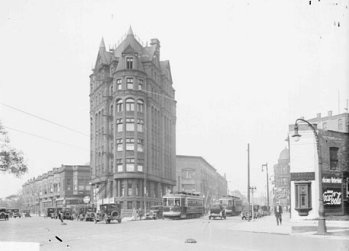I just got home to Colorado Springs from a week's trip to Chicago, and whereas a week sounds like a long time, well, it may be when you're 12. I am not 12. Poof! The week was there and gone.
But I had an idea yesterday that I'm going to pursue in this space. It's a challenge, to myself and to all of you, to engage in an outrageous experiment here in Contra. This will require the comments feature here on LiveJournal (alas, I'm not quite ready to move Contra over to WordPress yet) but that isn't the tough part. The aim of the experiment is to see if the larger “we” (again, myself and all of you) can engage in online political discussion completely devoid of anger.
I do not mean that you can't be angry; that's unreasonable and may be impossible. What I want you to do is write without anger. That takes some effort but it can be done, and it's a useful skill to have. I've found that forcing myself to write without expressing anger allows me to think more clearly. In some weird way, it decouples my anger from my rational mind and leaves it on a side track for awhile where it won't get in the way of the points I'm trying to put across.
Note that this is a challenge, but (for a limited time only! As not seen on TV!) it is also the rules. I have a rule for Contra that I don't invoke very often: You can be either angry or anonymous on my blog but you cannot be both. I delete ten or twelve comments a year from anonymous flamers who come out of nowhere and flame either me or someone in the comments. I sometimes give them a chance to identify themselves, but this rarely happens. Mostly I get another flame, and then the thread goes where all flames eventually go: Out. But until I finish up this series on politics, a new rule applies: No anger. It applies from today's entry until I call the whole thing done, which will almost certainly be when I go get my mouth worked on next week. Until then, angry comments will be deleted.
However, there's one final wrinkle: If and when I discern anger in a comment, I'm going to point it out in a nonjudgmental fashion and ask my readers if they agree that the message contains anger. I reserve the right to override the vote, but I promise to consider it seriously. A thumbs-up or -down is sufficient, but explaining why you agree or disagree with me regarding the presence of anger in the comment (not with the comment's factual content, which should be done separately) could be interesting.
I will be watching for the very human tendency to see anger more clearly in people you disagree with. I may or may not say anything, but I will be watching.
Let's see what happens.
_ . . . _
Some of the most reliable political theater (though generally not the best) proceeds from promised tax cuts. If I were to flip the Magic 8-Ball this second, it would predict that neither party will even attempt a tax cut in the next two years, irrespective of which wins. All the promises we've heard will be quietly forgotten, and probably explained by the obvious truth: We cannot afford to cut taxes at this time. The Bush tax cuts will quietly expire, and among the ill and elderly wealthy there will be more assisted suicides (both willing and unwilling) in 2010 than a civilized nation should tolerate. The Magic 8-Ball says no more than that, other than its standard mantra when answering political questions: “You are all behind me now.”
What I want to talk about tonight is another oft-heard mantra: “The rich aren't paying their fair share!” What never seems to come up in discussion is what the “fair share” would actually be. I want some hard numbers here. I remember reading of a psych experiment years ago in which people were asked a question something like this: “One man makes $10,000 a year. Another man makes ten times that amount. In a truly fair income tax system, how much more should the second man pay in income taxes than the first man?” The several choices ran from “The same” through an ascending scale of multipliers, like 2X, 5X, 10X, 50X, 100X, and 1000X. Overwhelmingly, people answered “10X” and seemed to think (as gleaned from subsequent discussions with the experimenters) that this was a progressive tax. It's not. It's a flat tax. The experiment was (if I recall) about leading questions, and this was only one question among many. But it suggests to me that we as a nation don't even remotely understand the tax system that we have, which is unsurprising, given that most Americans probably couldn't even lift the tax code. This makes the discussion difficult and complex.
We do have some hard numbers on the state of things as they now exist: 26% of Federal tax receipts come from the wealthiest 1%, which comprise 1.1 million individuals. The wealthiest 6% of taxpayers (5.6 million individuals) contribute 42% of all Federal receipts. The poorest 40% of Americans pay no Federal taxes at all beyond the Social Security payroll tax. And that's looking at Federal taxes generally; if you look at income taxes alone the picture is even more striking: For tax year 2005, IRS numbers tell us that the wealthiest 1% paid 39% of all income tax revenues. The top 10% paid 70%. This is a pretty progressive system. The question we need to ask ourselves as a nation is whether it's progressive enough, and we need to be brave enough to talk about real numbers.
There are two complications that need to be part of that discussion. First of all, the very rich have a great deal of control over how much their income is and when they get it. This is why tax receipts often go down when tax rates are raised: The rich simply cut back on generating new income and draw on their cash reserves until they call their tax guys and figure out which loopholes they can switch to in order to reduce their tax liability. This is in large part why the very rich have not been champions of the flat tax or other radical tax simplification schemes: Any such scheme would increase their liability hugely because such systems offer little flexibility and few loopholes.
The second complication is related to the first: It's not a good idea for the Federal government to depend on so few taxpayers for so much of its tax revenue, because the fewer people are paying, the “wigglier” and less predictable the numbers get. Even short-term planning becomes fluky, because a change in tax laws, or even an innovative new investment mechanism, can sweep across the finance business in less than a year, making previous tax revenue projections obsolete. The very rich share a common culture, and their money is “shaped” by a relatively few large banks and financial services firms. Small changes in the way money is handled are thus hugely leveraged.
I haven't even touched on the argument that everybody should pay something in income taxes simply to have a stake in the economy and the government. I only want to point out that Federal revenues would be a lot more stable and predictable if hundreds of millions of people are each paying a little (and those at the top paying a lot) than if only the people at the top are paying at all.
And on that note, I've got dogs to walk. More tomorrow. Remember: Keep your cool! (We may all learn something if you do!)
 I was given Carol's sister's old 2002-era Dell laptop recently, in hopes of degunking it and making it useful in Carol's hobby room for Web lookups. My approach in dealing with the machine was what I generally do: Leave it off-network, and plug in a USB thumb drive full of portable degunking utilities. Being in a hurry rarely leads to anything good, and what I was not used to was a laptop in which the USB ports are on the spine of the machine rather than one side or another. So I plugged it into the back, and at some time during my first ninety seconds in front of the laptop, I tipped it back and up on its spine to see if the battery lock had come loose on the bottom plate. The obvious result is shown above.
I was given Carol's sister's old 2002-era Dell laptop recently, in hopes of degunking it and making it useful in Carol's hobby room for Web lookups. My approach in dealing with the machine was what I generally do: Leave it off-network, and plug in a USB thumb drive full of portable degunking utilities. Being in a hurry rarely leads to anything good, and what I was not used to was a laptop in which the USB ports are on the spine of the machine rather than one side or another. So I plugged it into the back, and at some time during my first ninety seconds in front of the laptop, I tipped it back and up on its spine to see if the battery lock had come loose on the bottom plate. The obvious result is shown above. Somewhere in Chicago (Pete Albrecht and I are still trying to figure out precisely where) there was once a very Gothic-looking building with a giant turtle on top of it. It was the Turtle Wax turtle, of course, and it existed when I was quite young. Any time we'd be in the car passing by it, my folks would very carefully point it out. That would have been 1958-1962 or so. Pete thinks the building is the Wendell Bank Building at the intersection of Madison, Ashland, and Ogden, and it certainly looks right, though Pete remembers the sign being somewhere on Cicero and not Ashland. I confess that I have no idea, but that intersection would have been on the way to visit my grandfather and Uncle Louie, so it's a plausble hypothesis.
Somewhere in Chicago (Pete Albrecht and I are still trying to figure out precisely where) there was once a very Gothic-looking building with a giant turtle on top of it. It was the Turtle Wax turtle, of course, and it existed when I was quite young. Any time we'd be in the car passing by it, my folks would very carefully point it out. That would have been 1958-1962 or so. Pete thinks the building is the Wendell Bank Building at the intersection of Madison, Ashland, and Ogden, and it certainly looks right, though Pete remembers the sign being somewhere on Cicero and not Ashland. I confess that I have no idea, but that intersection would have been on the way to visit my grandfather and Uncle Louie, so it's a plausble hypothesis. The search for the abode of the Really Big Turtle did turn up an interesting little video on
The search for the abode of the Really Big Turtle did turn up an interesting little video on 










